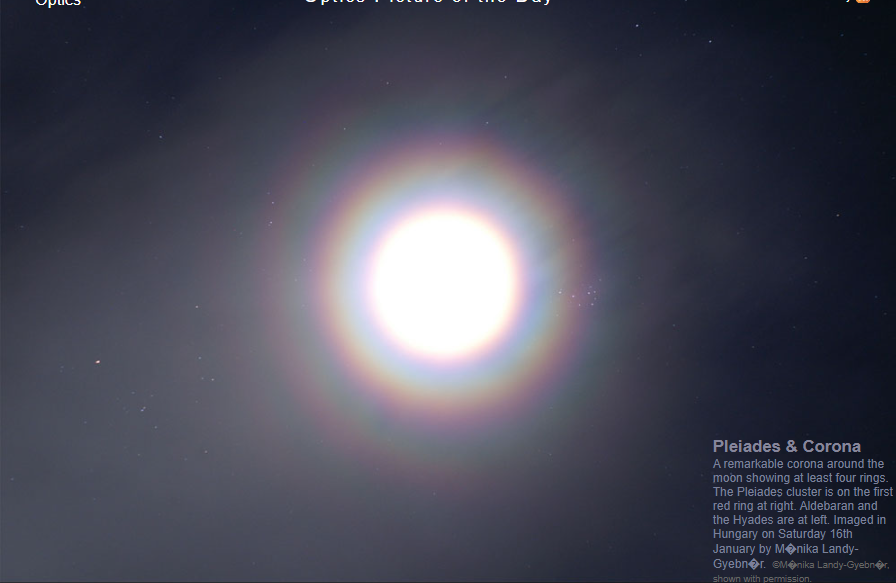OPOD - Corona 7 pl
OPOD - Corona 7 pl: A Spectacular Lunar Phenomenon
Have you ever witnessed a lunar corona? On the evening of January 16th, a remarkable corona around the moon captivated the eyes of observers in Hungary. This stunning display of atmospheric optics was documented by Mónika Landy-Gyebnár, who described it as the most beautiful lunar corona she had ever seen. Accompanied by Tamas Ladanyi, the pair had initially set out to photograph the hills of the northern shore of Lake Balaton in moonlight. However, their plans were thwarted by the arrival of clouds, one of which happened to be an altocumulus lenticularis, a cloud type known for creating exquisite coronas.
As the altocumulus lenticularis moved across the sky, Mónika Landy-Gyebnár sensed the opportunity for a breathtaking lunar corona. Within minutes, her intuition proved correct as the corona began to form around the moon. To add to the spectacle, there was also a conjunction between the moon and the Pleiades cluster, with only a separation of approximately 4.1 degrees when the photographs were taken. The resulting images showcased not just one, but at least four rings in the corona, each offering unique aspects and patterns.
What is a Lunar Corona?
A lunar corona is a fascinating optical phenomenon that occurs when light from the moon interacts with water droplets or ice crystals in the Earth's atmosphere. The corona appears as a series of colored rings surrounding the moon, often displaying shades of red, blue, and green. The size and intensity of the rings can vary depending on atmospheric conditions and the size of the water droplets or ice crystals involved.
The Role of Altocumulus Lenticularis Clouds
Altocumulus lenticularis clouds, also known as "lens-shaped" clouds, are renowned for their ability to create stunning coronas. These clouds typically form in the middle levels of the atmosphere and have a unique lens-like appearance. Their smooth, elongated shape allows them to diffract and scatter light in such a way that a corona can form around the moon or the sun.
The Pleiades Cluster: A Celestial Neighbor
Adding to the allure of this particular lunar corona was the presence of the Pleiades cluster. Located on the first red ring at the right side of the corona, the Pleiades cluster is one of the most recognizable and prominent star clusters in the night sky. Its proximity to the moon during this event created a visually captivating conjunction, further enhancing the overall beauty of the corona.
Observing the Corona: A Mesmerizing Experience
Watching a lunar corona unfold is a truly mesmerizing experience. As Mónika Landy-Gyebnár described, the corona showed various aspects and rings, each with its own intricate patterns and colors. The dynamic nature of the corona, constantly shifting and evolving, adds an element of wonder and awe to the observer. It is no wonder that this particular corona left such a lasting impression on those fortunate enough to witness it.
Capturing the Beauty: Photography and Animation
To preserve the ethereal beauty of the corona, Mónika Landy-Gyebnár not only captured numerous photographs but also created an animation spanning ten minutes. This animation allows viewers to witness the corona's transformation over time, providing a deeper appreciation for its intricate details and ever-changing nature.
Conclusion
The OPOD - Corona 7 pl showcased a remarkable lunar corona, capturing the hearts and imaginations of observers in Hungary. With the fortuitous presence of altocumulus lenticularis clouds and the conjunction with the Pleiades cluster, this corona presented a spectacle of rings and patterns that were truly awe-inspiring. Atmospheric optics phenomena like these remind us of the beauty and complexity of our natural world, and the joy that can be found in observing and documenting such wonders.

Pleiades & Corona
A remarkable corona around the moon showing at least four rings. The Pleiades cluster is on the first red ring at right. Aldebaran and the Hyades are at left. Imaged in Hungary on Saturday 16th January by M�nika Landy-Gyebn�r. ©M�nika Landy-Gyebn�r, shown with permission.
"This evening .16th. I saw the most beautiful lunar corona of my life (up until now).
With Tamas Ladanyi we traveled to the southern shore of the still frozen Lake Balaton to photograph the hills of the northern shore in moonlight - but by the time we got there (about 100kms from our town) lots of clouds had come.
It was only partly unlucky for me, because a big altocumulus lenticularis was part of the clouds that ruined our .intended. photo project. When I saw the Ac len, I told Tamas to watch for a nice lunar corona as Ac len is the best possible cloud to create it. And only a few minutes later the corona began to form. There was also a conjunction of the Moon and Pleiades (there was only about 4.1 degrees separation when I took the pics). The cloud moved on and the corona showed so many aspects and rings, it was amazing to watch it! In addition to the many pictures I created an animation of 10 minutes' of them .at left.."
Note: this article has been automatically converted from the old site and may not appear as intended. You can find the original article here.
Reference Atmospheric Optics
If you use any of the definitions, information, or data presented on Atmospheric Optics, please copy the link or reference below to properly credit us as the reference source. Thank you!
-
<a href="https://atoptics.co.uk/blog/opod-corona-7-pl/">OPOD - Corona 7 pl</a>
-
"OPOD - Corona 7 pl". Atmospheric Optics. Accessed on October 21, 2024. https://atoptics.co.uk/blog/opod-corona-7-pl/.
-
"OPOD - Corona 7 pl". Atmospheric Optics, https://atoptics.co.uk/blog/opod-corona-7-pl/. Accessed 21 October, 2024
-
OPOD - Corona 7 pl. Atmospheric Optics. Retrieved from https://atoptics.co.uk/blog/opod-corona-7-pl/.